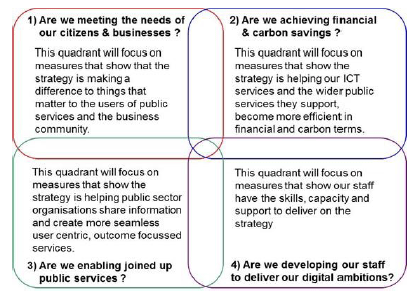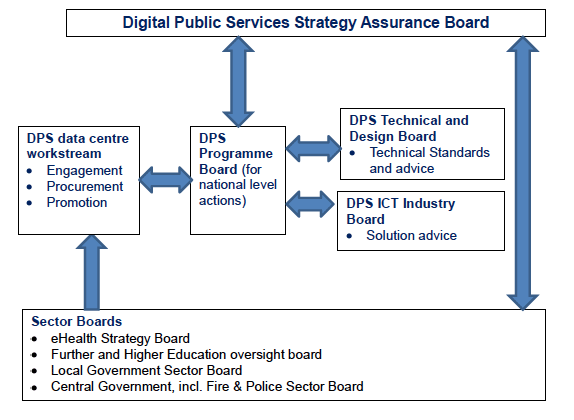Scotland's Digital Future: Data Hosting and Data Centre Strategy for the Scottish Public Sector
The data hosting and data centre strategy sets the vision that Scotland’s public sector data hosting is cost-effective, carbon neutral and makes appropriate use of cloud technology, for the delivery of efficient and highly available ICT services.
Implementation:
Measurement and benefitsThis strategy's implementation will deliver against the wider Digital Public Services Measurement and Benefits Framework.
The Measurement and Benefits Framework contains 16 measures which provide comprehensive coverage of the main benefits areas arising from the activity set out in Scotland's Digital Future - Delivery of Public Services Strategy.
The four score quadrants are shown in the diagram below, each of which links to key policy priority areas for the Scottish Government.

This strategy will measure its benefits against quadrant 2 "are we achieving financial and carbon savings?"
There are two benefits that we will measure for all digital delivery and they are
Benefit 10 - Our Public Bodies are saving money through increasing collaborative ICT procurement.
Benefit 11 - We are helping to reduce Scotland's carbon footprint.
For data hosting, organisations will need to capture data to ensure we can have an understanding of the trajectory of:
- Total cost of hosting arrangements
- Carbon footprint of hosting arrangements
Monitoring in the following areas will also support assessment of progress (though less so if a cloud service is chosen) :
- efficiency in use of power
- data centre floor space
- efficiency of data centre ICT assets
- matching of data centre ICT facilities to business need
- standardised ICT infrastructure architectures and use of new technologies
- use of cloud services
This strategy has been developed with and endorsed by the Digital Public Services Programme Board for National Level Actions and endorsed by the Digital Public Services Strategy Assurance Board. Members have committed to driving implementation across the sectors and bodies whom they represent.
It is for individual organisations to assess their own requirements, understand the cost of their activities, and take action to meet their requirements in a cost effective way. But there are important roles at national level to support this, in particular:
- to provide advice and guidance on key issues, notably use of cloud computing, but also how to assess the cost of data hosting, and the assessment of alternatives based on the decision route maps options
- ensuring that there are straightforward routes to market for cost effective and secure access to cloud computing which do not require individual organisations to build duplicate expertise (through development of appropriate procurement approaches, which should ensure that any cloud options meet the essentials in terms of security, scalability etc., and, potentially, leverage the buying power of the entire public sector)
- to provide a catalogue of existing good quality public sector data centres
It is then for individual organisations to make the most cost-effective choices that meet their business requirements.
Sector boards will monitor progress in implementing the strategy in their sectors. However, collaborative approaches to more efficient data hosting do not need to be pursued only or mainly on a sectoral basis: cross-sectoral cluster or geographic approaches can also be effective.
Progress of sectors to consolidate data centre activities will be considered annually by the Digital Public Services Strategy Assurance Board.

Our National Level Actions which will support change at sector and organisation level.
| Action | Timescale |
|---|---|
| Publish and promote the strategy, continually reviewing it to maintain its effectiveness | April 2014 |
| Publish a Scottish public sector cloud usage policy |
|
| Publish guidance on virtualisation | Q2, 2014 |
| Identify and publicise existing Public sector data centres for co-location | Q2, 2014 |
Continue the work with procurement and engage further with Business Strategy and ICT Leads to
|
new procurement arrangements by Q4 2014 |
Continue engagement across the public sector to
|
Q2 2015 |
| Review the strategic objectives in line with technology developments and progress across the public sector | Q1 2016 |
Contact
There is a problem
Thanks for your feedback